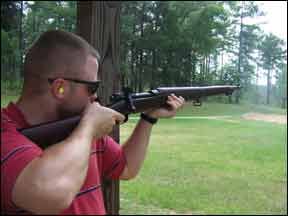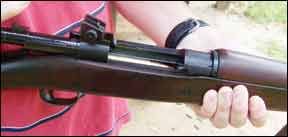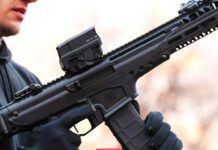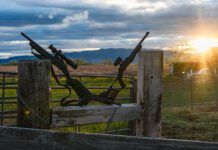During World War I and World War II, and in some cases beyond, there came four great bolt-action rifles in martial actions: the Lee Enfield, the Mauser, the Mosin Nagant and the Springfield. While there were many variations among the rifles, we all know what a Lee Enfield and a Mauser look like. The Nagant was produced in the many millions, and the Springfield is sometimes regarded as a rifle with almost magical accuracy. These rifles wrought many a bloody victory for one side or the other in warfare from about 1903 onward. The Lee Enfield and Mauser rifles are still seen in action in Afghanistan today. Recent events in India showed Indian security forces armed with the Lee Enfield, probably a homegrown version. These rifles simply refuse to die. While these four are the great battle rifles of the 20th century, there were other contenders for the test program that were considered and discarded. The excellent Schmidt Rubin straight-pull rifle was considered, but since it didn’t figure into warfare it was not included. The French rifles are a bit quirky for our tastes, and ammunition is difficult to obtain. Likewise, the Italian Carcano is not really in the league with the others. We admit the Japanese Arisaka is an omission, but we were unable to find a suitable firing version within our time frame. We used four rifles primarily during the test program and added two special interest rifles for a side comparison as well. In the end we think we have a good idea of the handling properties of the rifles used in the Great Wars.

The Contestants
In more detail, one of the participants was the Lee Enfield No. 4 Rifle 303 British, $375. This is the final and best Lee Enfield variant. With good steel and a high receiver bridge and narrow clip slot, the Enfield No. 4 is the strongest Enfield variant. The replaceable bolt head allows adjustment of headspace in well-worn rifles, and the superior gas-escape system provides greater safety compared to earlier Lee Enfield variants. The Lee Enfield features a positive safety mounted on the left side of the receiver and a 10-round removable box magazine. The Enfield was normally loaded with 5-round stripper clips during war time use. Our rifle was produced at the Canadian Long Branch Arsenal.
Next up was a Mauser 98 Rifle, 1938 Turkish 8mm Mauser, $190, produced in the 1930s. It is longer than the German World War II-issue 98K, but it’s comparable to the many Mauser rifles used during World War I. While modestly priced, the Turkish Mauser is well made. Our test rifle featured the original straight bolt handle and the famous Mauser bolt-mounted safety. The safety offers a flip lever for Safe (locking the bolt on Safe while allowing the bolt to be manipulated) and Fire settings. The rifle feeds its 8mm Mauser

cartridges from a 5-round box magazine fed by stripper clips. The sights are the standard leaf style used by Germany during World War II. We also examined and shot a secondary Mauser, a Yugo 48, which is a basic variant of the Mauser 98K rifle.
The big, heavy Moisin Nagant 7.62mmx54R, $160, was developed in the early 1890s. It is a contemporary of the Krag-Jorgensen and the Carcano rifle. The bolt action featured a cocking handle that juts at a right angle from the receiver, and the safety requires the cocking piece to be pulled to the rear and turned at an odd angle. The rifle shows advanced bedding technique, and while utilitarian in appearance, we thought it was well finished. We also tested a Finnish Nagant, a variant said to produce superior accuracy. And, of course, we recently compared two M-Ns in the October issue, recommending one of the two. But those guns were shot head to head, in isolation from other wartime choices, so this evaluation puts them in perspective with other bolt actions you might want to consider.
The priciest rifle in the test was the Springfield 1903A3 Smith Corona 30-06 Springfield, $675. This rifle, produced by Smith Corona, is similar to the Mauser in operation, with a similar safety and locking lugs. The Springfield is noted for good accuracy and smooth operation and owes some of its design to the Krag-Jorgensen rifle as well as the Mauser. The 1903A3 differs from earlier Springfield rifles because of its aperture rear sight. It loads with a 5-round magazine fed by a stripper clip.
How We Tested
We used the standard 100-yard benchrest firing test as a benchmark for these rifles. Gilt-edged accuracy is not the only criteria. After all, we are testing these rifles some 70 years after the fact, more in some cases. We also conducted extensive handling tests. We compared the smoothness of the bolt in rapid manipulation, handling the safety, reloading the rifles at speed, and also the ease with which the safety lever was operated. We also conducted a firing test at a 50-yard target to determine how quickly we could snap-shoot and hit a target in combat-style shooting. Follow-up shots were taken, and the whole picture carefully rated. We compared the sights. We qualified felt recoil. Quality of fit, finish were important. While the rifles were mass produced, some showed fine attention to detail.
We tried to be fair in ammunition selection. There isn’t much variety for the 7.62×54 R and 8mm Mauser, or the 303 Enfield, at least without handloading. Using handloads may have given one rifle an advantage over the other, but in practical use most of you will use handloads if you buy one of these models.
In the Russian Mosin Nagant, we fired Wolf Gold 7.62x54mm Rimmed Russian G54RSP1 180-grain jacketed softpoints ($20/20, #989895 at MidwayUSA) and Wolf Gold G54RFMJ1 150-grain full metal jacket rounds ($20/20, #614792 at MidwayUSA). Made to SAAMI specifications, the Wolf Gold ammunition features boxer primed, copper-jacketed bullets. They were new-production non-corrosive, reloadable-brass-case ammunition. Factory specs for the 180-grain round show muzzle velocity @ 2641 fps and muzzle energy @ 2875 ft.-lbs. Those readings for the 150-grain round were 2838 fps and 2682 ft.-lbs. respectively.
The 8mm Mauser, aka 8x57mm Mauser, is drastically underloaded by American ammunition makers, simply because there are two common bore sizes in 8mm Mauser, the .318 and the .323. Commercial ammunition is loaded with .323-inch bullets for accuracy, but loaded light enough so that the .323-inch bullet will not blow up a rifle if forced down a .318-inch bore. Instead of commercial ammo, we used a handload supplied by one of our testers with the Barnes 180-grain FXB bullet and enough H380 powder to produce 2690 fps. This represents true 8mm Mauser performance. The second load was the Winchester Super-X X8MM 8mm Mauser 170-grain Power-Point ($35/20, #451420 at MidwayUSA). This ammunition is new production, non-corrosive, in boxer-primed reloadable brass cases. Factory muzzle velocity was 2360 fps, and we got about 2300 fps — a substantial step down from the handload.
In the Springfield 30-06 we used the Hornady 165-grain jacketed soft point SST over enough IMR 4350 to deliver 2400 fps, a lighter-than-standard load that delivers good accuracy, we have learned. With the same bullet, we ramped the powder charge up enough to produce 2900 fps to provide an example of a full-power 30-06 load. A commercial load that uses the same bullet is the Hornady Custom 81154 30-06 Springfield 165-grain Super Shock Tip ($25/20, #182095 at MidwayUSA). SST bullets provide a higher ballistic coefficient than many other hunting bullets because they have sharp, pointed polymer tips. Factory specs have it running 2800 fps at the muzzle and producing 2872 ft.-lbs. of energy. The Hornady Superformance 81153 load likely matches our IMR 4350+ handload listed in the accuracy/chrono table. That cartridge pushes the 165-grain SST to factory readings of 2960 fps MV and 3209 ft.-lbs. ME, which could certainly tail off to 2900 fps in an old bore like the Smith Corona’s. It’s #194532 at MidwayUSA, and costs about $27/20.
For the 303 British, we used Wolf Gold 303 British 174-grain Full Metal Jackets No. G303FMJ1 ($21/20, #172244 at MidwayUSA) at 2350 fps for the bulk of the testing. We switched to a handload with a Hornady 150-grain JSP and enough IMR 3031 to make 2670 fps for accuracy shooting.
The results in accuracy testing were interesting, and the Lee Enfield gave a better show than we could have imagined. The Mosin Nagant, for its vaunted accuracy, was at the bottom of the heap. The Finnish rifle did better, but was no tackdriver, by our standards. The 1930s-produced Turkish Mauser and the Lee Enfield were similar, with the Yugo 98K tested as a sideline that came out inferior to the Turkish Mauser. The Springfield was easily the most accurate. Remember, some of us have fired only well worn old war dogs. When you fire a good rifle in excellent condition, accuracy can be much better than expected. As far as that goes, however, the Mauser was well used and the Nagant unissued as far as we could ascertain. The Springfield was in very good condition and so was the Enfield. In terms of power, any way you slice it, the 30-06 is the most powerful cartridge, as the accompanying table shows. We would estimate that any difference between the 8mm Mauser and the 30-06 on the battlefield would be purely conversational.
Power has its negative side, of course — recoil. The most pleasant rifle to fire was the Lee Enfield. A combination of a mild service cartridge with modest but effective ballistics and the weight of the rifle added up to a modest jolt. This light recoil aided in long firing strings and in making follow-up shots. The Turkish Mauser kicked a bit more than the Lee Enfield, our testers said. The Nagant definitely gave a kick, but the Springfield was clearly rated as the hardest kicker. Also, the Springfield’s straight stock was sometimes criticized as being too short, and, indeed, one of our raters nearly got a bloody nose from the Springfield.
The bench results were one thing. Then we tried snap-shooting at 50 yards to assess speed to a first-shot hit, then we made follow-up shots. The test was undertaken in two stages. First, we began with the rifle on safe and then shouldered the rifle and tried for an X-ring hit, standing, at 50 yards. Using the sling was not allowed, and the goal was to shoulder the rifle and fire within a very few seconds. We did not record the shot times; instead we simply ranked them best to worst by setting a time with one gun then trying to beat it with the others. When we started with the safety on, the Nagant was hopeless. Our burliest raters experienced difficulty in quickly moving the safety to the firing position. The king of snap shooting was the fast-handling and well-balanced Springfield 1903A3, followed closely by the Enfield then the Mauser.
Next, we did follow-up shots, firing a total of five rounds quickly at the same range. (The Lee Enfield could have delivered 10 shots, the others were 5-shooters.) When it came to the 5-round strings the Enfield walked away with the show. The cock-on-closing bolt and the famous short throw of the Lee Enfield outran the Springfield’s first-shot hit capability. The extra recoil of the Springfield did not help. The Mauser rifle was very close to the Springfield, even with the supposed disadvantage of a straight bolt handle. We believe the Mauser sights were holding it back in this drill. The fast-to-acquire peep sights of the Springfield and the Lee Enfield were by far the best sights for the game at hand. The Nagant was the tail end rifle in this test as well.
Fit and Finish
The best fitted and finished rifle by vote was the Mauser. Even though the rifle was well worn, the craftsmanship showed. This is no surprise as the rifle has a reputation for German craftsmanship. This is despite the fact that the Turkish Mauser is usually the least expensive of all Mauser rifles on the market. Next was the Smith Corona Springfield, with the Nagant and the Enfield more or less equal.
Sights
Advocacy for one sight system or the other was split between the Lee Enfield and the Springfield. The Springfield sights were rated best for precision, while the Lee Enfield was the better design for speed of fire, we thought. Of course, the Enfield has the ladder sight and the Springfield does not. This adds to versatility. There was nothing to choose from between the Mauser and Nagant rifles. Both were old-style military leaf sights.
Safety Mechanism
The handiest and the fastest according to the raters was the Lee Enfield safety. It falls under the thumb quickly. The much-praised Mauser-type safety is a fine all-round arrangement, handy, fast enough, and positive. The Springfield and the Mauser were equal in each regard, with the Mauser perhaps a bit smoother, but the Turkish Mauser was well used. The Mauser wing safety had its adherents in its day and remains the most popular safety arrangement of all time. A similar arrangement is found in the modern Ruger 77 rifle. Odd that the Enfield safety mechanism no longer exists in modern production.
Our Team Said: As a test of war rifles, the Lee Enfield came in at the top of the heap. We all agreed that if we had to go into combat in any of the World Wars or any other role resembling combat, the Lee Enfield would be our first choice. The Lee Enfield features an action with plenty of tolerance built in to allow the rifle to fire when invaded with dirt and mud — a big plus for a war piece. But for today’s recreational or game shooter, it stretches cases and makes reloading difficult. It is also the least powerful rifle tested.
Most of us are hunters, and the Springfield would be the team’s first choice for hunting game. The most accurate rifle, it would be a fine choice for recreational target shooting as well. For handloaders, the Springfield in 30-06 offers plenty of options. Though the Lee Enfield is a fight-winning rifle, the Springfield Smith Corona makes more sense for today’s collector/shooter, we believe.
Elsewhere, the well-made Mauser gave the most performance for the money, but it’s not up to the standard of the Enfield and Springfield, we thought. With the others to pick from, we don’t see any reason to buy a Mosin Nagant except as a shooting collectible.
1211-CLASSIC-MILITARY-ACC-CHRONO-DATA.pdf



























